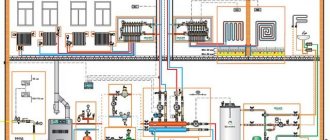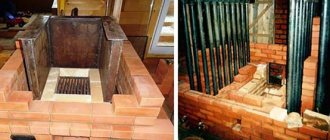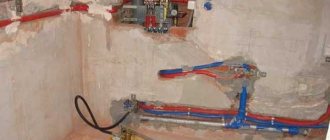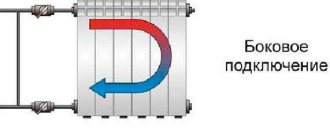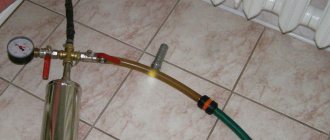Today a cottage is fashionable and prestigious. But we must remember that having such a suburban building is somewhat problematic. Especially if it is used as a permanent residence. In this case, the issue related to the equipment of a high-quality heating system arises. After all, for a house to be pleasant to be in, it must be warm. There are different methods of heating a country house, each of which needs to be well understood in order to make a choice in favor of the most effective heating system that best meets all requirements and capabilities.
How can you heat a cottage?
Cottages, unlike multi-storey residential buildings, are not connected to a centralized heating system. After all, they are located outside the city. Therefore, for such an object it is necessary to create an autonomous type of heating. Many, when thinking about organizing heating for a country house, consider the option of creating a heating system with their own hands rather skeptically. And in vain. After all, equipping the system yourself is not so difficult. The main thing is to choose the appropriate type of heating and know some installation features.
It is advisable to decide on the heating option for the house at the stage of its construction. When calculating heating system parameters, many different factors are taken into account:
- building area;
- number of floors;
- used thermal insulation and building materials.
Every cottage owner wants heating to be comfortable and fuel consumption to be economical. Today, different types of heating of a country house are used: water, stove, gas, electric, etc. Each of them has its own characteristics, positive and negative aspects. Sometimes heat pumps or additional heating sources are used to optimize the operation of the heating system. Recently, solar collectors have been of great interest to homeowners.
Optimal contour geometry
When optimizing the geometry of the circuit, in addition to the quality of the heating wiring in a private house, they usually focus on the following factors:
- minimizing material costs for laying pipes;
- ease of installation;
- aesthetics of the result of heating wiring - it is important that the elements of the system can be organically integrated into the interior.
Natural and forced water circulation
According to the mechanism for delivering coolant to radiators, water circulation can be divided into natural, that is, occurring due to the occurrence of a difference in hydrostatic pressure in the pipes, and forced, carried out using a circulation pump.
Among the advantages of natural circulation in comparison with forced circulation, it is worth highlighting:
- simplicity and low cost of installation;
- no noise during operation.
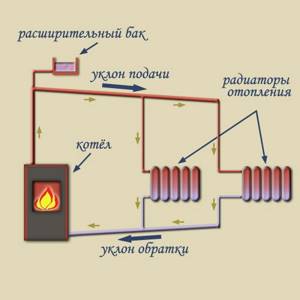
At the same time, the advantages of forced circulation are:
- short warm-up time compared to natural;
- applicability for multi-storey buildings.
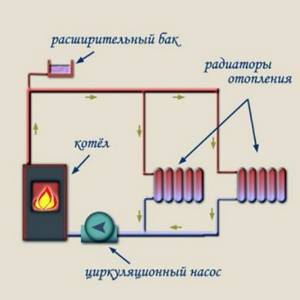
Vertical and horizontal wiring
What is the correct heating installation in a private home? According to the orientation of the supply pipes in space, the following types of heating distribution are divided: vertical, for which natural circulation is usually used, and horizontal, for the implementation of which a circulation pump is often necessary.
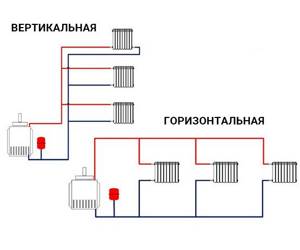
To understand how to properly route pipes, you should consider the advantages of each option.
Vertical layout
- operation at relatively low pressures in pipes, which reduces the likelihood of an accident;
- may continue to operate if the pump is turned off for one reason or another.

Horizontal layout
- aesthetics - this type of wiring fits perfectly into the interior or is camouflaged;
- small total length of pipes, and therefore minimal costs for them.
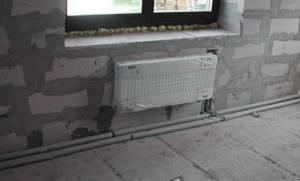
Stove type cottage heating
Of course, today heating a cottage using a stove is not particularly relevant and is gradually becoming a thing of the past. However, in some cases this is the only possible heat supply option. This method guarantees no problems with fuel and is relatively simple. Wood waste or firewood is available almost everywhere and always.
If the cottage is located near a forest, then a potbelly stove for heating the house is an ideal option. Such a stove can be used not only for heating a room, but also for heating water and cooking food. Modern models are designed for buildings with a total area of 60 square meters and are highly efficient devices. Sometimes such equipment is used as an addition to the main heating system.
Stove heating has some disadvantages:
- bulkiness of the oven;
- heating takes a long time. True, the oven also cools down slowly;
- insecurity. Especially if the family has small children. The equipment must be carefully monitored during operation: there is a possibility of backdraft and burns;
- the device cannot be automated.
Therefore, today modern heating systems for country houses are more often used, which are more efficient and easy to use.
Checking and configuring the system
After all heating equipment has been connected, you should make sure that the work done is correct. To do this, the system is filled with coolant, after which you need to monitor it and check for leaks.
Then the boiler starts. Heating the liquid will allow you to finally verify that the circuit has been assembled correctly and that there are no violations.
If a mistake was nevertheless made and a leak was discovered somewhere, then for this you need:
- drain the coolant;
- correct the defect;
- check again.
The final stage is sealing the grooves where the pipes were laid. If the installation was carried out on the floor, then the best solution is a screed. When the pipeline is installed on a wall, putty or plaster is used. Next, you can do finishing work.
Gas type cottage heating
At the moment, using gas boilers for heating is the most cost-effective and convenient option. Naturally, gas heating of a country house is used only if main gas is supplied to the building. Otherwise, installing a gas system will be very expensive.
Gasification of a residential building is a lengthy procedure that requires collecting a package of documents and obtaining permission.
True, this type of heat supply has a number of advantages. For example, high efficiency, environmental friendliness, cost-effectiveness, accessibility. In this regard, many people wonder where to buy a gas boiler to equip an efficient system. But we must also take into account some disadvantages. There are few of them, but they are significant: fire and explosion hazards. These troubles can be avoided through proper installation and periodic maintenance.
Lemax boilers
The market offers many different models of gas-type boilers to choose from. Many people prefer Lemax equipment. The company produces several models of boilers. All Lemax wall-mounted and floor-mounted gas heating boilers have only positive reviews. Users highly value Lemax devices for their ease of operation and maintenance, elegant design, additional features and high quality. The new series boilers can perfectly heat a room, regardless of its size. Today Lemax is a worthy competitor for many domestic and foreign manufacturers.
Ariston boilers
Ariston gas boilers, which are designed for heating private houses with an area of up to 500 sq.m., are also widely popular. The units of this company are universal: liquefied or regular gas can be used as fuel. Many people opt for wall-mounted, double-circuit models. After all, in addition to heating the house, they also perform the function of providing hot water for domestic purposes. The cost of Ariston boilers is quite acceptable for the average consumer.
Boilers Buderus
Buderus boilers are also often used to equip the gas system. Considering reviews of Buderus wall-mounted double-circuit gas heating boilers, one cannot help but note such positive qualities of units of this brand as ease of operation, stylish design, compactness and durability. The equipment can be used in premises of any size. It is also worth noting that the boiler is compatible with all smoke exhaust systems. Efficient automation allows you to use gas more economically.
Ross boilers
We cannot ignore Ross gas boilers, which are distinguished by the optimal combination of price and quality, for which they are so valued by domestic consumers. The units are characterized by energy saving. The power can be adjusted manually. All models are equipped with reliable automatic control.
Navien boilers
Navien also specializes in the production of high quality gas boilers. A special feature of the equipment is that it is adapted to domestic operating conditions. The products can withstand low gas pressure and power surges. Looking at the reviews of the Navien gas boiler, we can say that most users prefer the products of this particular manufacturer due to the cost-effectiveness and durability of the equipment.
Main stages of installation
When you plan to install a heating system in a completely new house, the best solution would be to think through all the nuances at the design stage.
Preparation for drafting
A well-designed diagram and calculations carried out by a specialist will allow you to solve many problems “in the bud.” For example, this approach will allow you to find out whether it is necessary to allocate a separate room for the boiler room.
Before starting finishing work, it is recommended to take care of where and how the pipes will be hidden. The best solution is to install the heating system before screeding the floor.
Experts recommend starting to design and select equipment only after the thermal circuit of the house has been closed. That is, this needs to be done after the doors, windows have been installed and the roof has been covered.
To simplify the process of installing a cottage heating system as much as possible, the work is divided into several main stages:
- choosing the type of heating system;
- design and calculation work;
- ordering equipment;
- arrangement of a boiler room;
- installation of radiators;
- carrying out commissioning works.
Each of the steps listed above has its own characteristics. Knowing all the intricacies in this area, any beginner can cope with installation at the highest level, and the equipment will confidently last for many years.
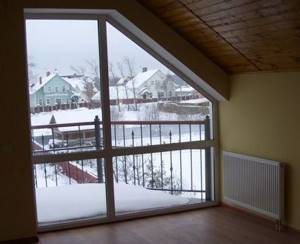
Particular attention should be paid to the season. It is better to install the heating system in the warm season. After all, the cold will negatively affect the quality of building materials. In addition, you need to calculate everything in such a way as to meet the harsh winter in warmth and comfort.
Selecting the coolant type
Manufacturers offer a wide range of heating equipment. On the one hand, this allows you to choose everything you need to implement the most complex and uncomplicated system.
But with such a large model range, any unprepared buyer will undoubtedly have a lot of problems. Therefore, before going to the store, you should understand this issue in as much detail as possible.
There are several types of heating systems. So, depending on the coolant, it happens:
- air;
- water;
- steam
Airborne equipment, as the name suggests, uses air to transfer heat. It is taken from outside the building, heated and delivered directly to the desired area. The main advantage of such a system is its security.
Its disadvantages are low heat transfer, high cost, and to carry out installation, you will have to go deep into technical literature.
The easiest heating system to operate is water. This equipment uses water, antifreeze or a mixture of them in a certain proportion as the coolant. But you have to pay for simplicity (literally). After all, in order for the liquid to move, you will need to install a pipeline, install radiators and a unit for heating it.
Steam plays a major role in the installation of steam heating, but it will be necessary to build steam pipelines and install pipes for collecting condensate. And when using a heating stove, hot gases transfer heat into the room through its walls, passing through channels.
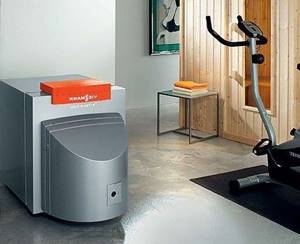
As for liquid systems, today they are the most popular. This is due to their ease of installation and high efficiency. Such equipment is divided into single- and double-circuit
One option is electric heating, i.e. system without coolant. To obtain heat you need electricity, and it is transmitted through a solid medium. Autonomous infrared or oil batteries, electric convectors, electric fireplaces or special fans are used.
But you have to pay for simplicity (literally). After all, such equipment uses a large amount of electricity. And its performance is quite low, which makes it a profitable solution only for rare use in small country houses.
How many circuits should I equip?
The main difference between a double-circuit boiler is that it heats water both for heating the room and for the hot water system. On the one hand, this is beneficial, since the purchase and maintenance of such equipment will be cheaper than the purchase of single-circuit devices and a separate arrangement of a hot water supply system.
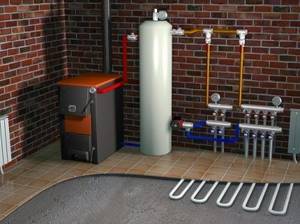
It should be understood that in order to ensure a constant temperature of hot water, you will have to constantly expend energy or install additional equipment to save
And also with a double-circuit boiler, you still have to choose the type of heater between flow-through and storage. Considering that the first option is convenient for a family of 2-3 people, and the second will save fuel, but will require space for an additional tank to store hot water.
As for the single-circuit system, today this is the best solution for many cottages. It assembles faster and requires fewer components.
Boiler fuel type
Boilers for heating systems are divided into categories depending on the type of energy source they use. There are gas, solid fuel and liquid fuel equipment, as well as devices that run on electricity. Before making your final choice, it is recommended to evaluate which type will be most beneficial.
It is also worth paying attention to whether there is a network gas pipeline close to the house, how accessible solid and liquid fuels are in the region, and whether there are problems with the stability of the electricity supply.
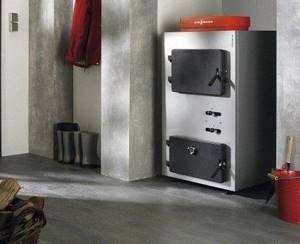
When installing equipment that uses solid or liquid fuel as an energy source, it is necessary to understand where coal, firewood and other supplies will be stored
The most profitable solution would be to install a gas-fired boiler. But its installation will require some financial investment and time. After all, you will have to obtain the appropriate permission. There will also be a problem in allocating space for storing fuel reserves if a gas holder is installed or if a liquefied cylinder analogue is used instead of network gas.
Design and calculation work
Once the issue related to the type of heating system has been resolved, you can begin to develop the project. If the cottage has fairly modest dimensions, then you will be able to do all the calculations and draw up a diagram yourself.
But the best solution would be to entrust this work to an experienced heating engineer. A professional will make all the calculations correctly, which will avoid many problems that may arise during the installation stage.
When developing a heating system project, the document should indicate:
- radiator installation location;
- a method for eliminating combustion products, if any;
- the place where the boiler will be installed;
- a detailed pipeline layout plan, which precisely indicates the location of fittings, taps and other elements.
It is recommended to order design and calculation work only from trusted companies that have permission to provide this type of service. This is often done by organizations that work in the field of installing heating systems or selling the equipment needed for this.

By spending once, you can save more than one day, which will be needed to study all the necessary technical documentation, and many hundreds of dollars, which will have to be paid in the future for mistakes made at the design stage
All calculations can be done independently. To do this, you need to understand the drawings, diagrams and detailed descriptions in the reference literature. You will need to take a closer look at information about the characteristics of the heat generator, the type of wiring, the general network configuration, the location and specifications of the equipment, and so on.
Purchasing the necessary equipment
When the type of boiler has been chosen, you should decide on its power, taking into account that the productivity of the equipment for a double-circuit system should be greater, since in this case the heat losses will be much higher.
Correctly calculated boiler power means that the temperature in the combustion chamber will not exceed 90 degrees Celsius. By following this rule, the equipment will last much longer. For example, for a cottage with an area of 100 m2, the best solution would be equipment with a power of up to 15 kW.
The next thing you need to install a heating system is heat transfer devices. To correctly calculate radiators, you need to decide on the number of these elements and the number of sections. Their characteristics depend entirely on the size of the living rooms. As for the material, experts recommend choosing cast iron products or bimetallic models.
The last detail to pay attention to in the shop is the pipes. Polypropylene products are preferable. They are distinguished by ease of soldering and low weight, which allows you to do the installation yourself, without the involvement of specialists.
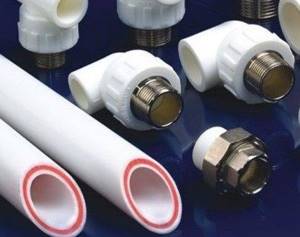
Do not buy large quantities of pipes and fittings. Follow the previously developed heating system diagram
Installation of a boiler room in the house
Once all the necessary equipment has been ordered and delivered to the site, you can begin installing the heating system. When installing, it is important to strictly follow the project documentation, which will avoid problems and unplanned financial expenses.
The heating device is installed as specified in the manufacturer's manual.
In the absence of manufacturer's instructions, the following basic rules should be followed:
- there must be at least 1 m of free space in front of the boiler, and about 70 cm in the back and sides;
- The device must not be installed closer than 70 cm in relation to other devices;
- If two or more boilers are installed, a distance of about 2 m should be left between them.
If wall-mounted equipment was ordered, then more lenient requirements are imposed on it. For this type of heating boiler, you only need to leave enough space for easy access to the device.
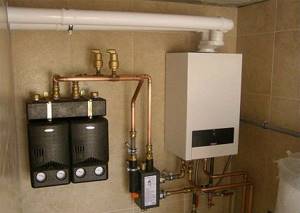
Installation should begin with the main element of the system - the boiler. If a low-power device (up to 60 kW) is used, it can be installed directly in the kitchen, hallway or pantry. If the productivity of the device exceeds the above number, then a separate room will have to be allocated for the boiler
Chimney and combustion products outlet
The next stage of installation of a cottage heating system is the organization of the chimney. With an improperly designed chimney, there is a risk of a fire in the house or a chance of carbon monoxide poisoning for residents.
It is recommended to build a structure for the removal of combustion products from metal, brick or ceramics. A ceramic chimney is the optimal solution in most cases.
Ceramics harmoniously combine low heat transfer and modular design. The only drawback of such a chimney is its high cost. In addition, the structure must have a strictly vertical configuration.
As for metal products, they will be an ideal solution for liquid and gas equipment models. After all, such chimneys are resistant to mechanical and chemical influences. The list of advantages should also include ease of installation (the design is assembled from modules).

The main disadvantage of a metal chimney is quite large heat losses
Brick chimneys are most often used with solid fuel boilers. Their main advantage is low heat transfer, but construction should only be carried out by a qualified specialist.
When designing a chimney, it is important to adhere to the following rules:
- A canopy must be placed at the end of the structure. This element will provide protection from moisture and foreign objects;
- the shape of the chimney should be round. In this case, fuel combustion products accumulate less;
- the number of chimney turns cannot exceed three;
- the structure is installed half a meter above the flat roof, and for the ridge this parameter is 0.5-1.5 m.
If a decision has been made to install an external chimney, then a certain standard must be adhered to. Experts recommend placing such a structure upward at a distance of at least half a meter from the roof surface.
Installing radiators in the house
Installation of radiators requires compliance with certain rules. First of all, they should be installed exactly horizontally, without any distortions. If a single-pipe heating system is being assembled, then it is advisable to place the radiators at the same level.
To minimize heat loss, the elements need to be fastened at a distance of 8-12 cm from the floor and window sill, as well as 3-5 cm from the wall. In addition, the size of the radiator must be at least 3/4 of the window dimensions. This will prevent condensation from forming.

The best choice would be brass adapters and fittings. If we compare them with other products offered by modern manufacturers, their main features are versatility (the above metal interacts well with absolutely any materials), good heat transfer and corrosion resistance
Today, three methods of connecting radiators are used: side, diagonal and bottom. The first option, in turn, is divided into one-sided and diagonal. Also, sometimes experts prefer the saddle method.
Which way is better? When installing a heating system in a newly built cottage, the ideal solution would be the bottom connection method. It allows you to install pipes into the floor, hiding them under the screed. This will save precious square meters, and also make the interior of the room more harmonious and neat.
Cottage heating using diesel fuel
In most developed countries, diesel fuel is used to heat rooms. Experts believe that such a cottage heating system is a good alternative to gas heating. True, equipping the system will require a considerable budget: the boiler itself is expensive, and in addition to it, you will also need to equip the boiler room, fuel storage, install the system and create ventilation. But in the end, the homeowner receives reliable, high-quality and safe heating. The installation does not require frequent maintenance: it is enough to carry out an inspection once a quarter.
Application of two-pipe heating option
With two-pipe heating, the coolant leaves the boiler through the supply pipe and is delivered through it to the radiators, from where it goes through the return pipe back to the boiler.
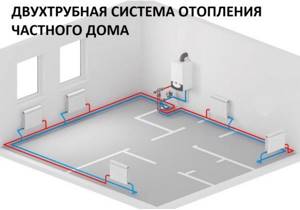
The advantages of this heating scheme are:
- uniform heat distribution in the room;
- the ability to adjust the heating intensity by completely or partially turning off one or more batteries;
- possibility of heating multi-storey buildings.
There are not many disadvantages of this system, but they do exist:
- the total length of the pipes is longer than with single-pipe heating, which means the costs for them are higher;
- in tall buildings you cannot do without a circulation pump.
Two-pipe system with top wiring
With this system, supply pipes run under the ceiling and along the walls. The principle of operation of this system: from the boiler, which should be located as low as possible, the hot coolant flows through vertical pipes into an expansion tank installed at the highest point, from where it is delivered to the radiators. Next, the cooled water flows through return pipes back into the heating boiler.

This wiring is suitable for multi-story buildings. The advantages include:
- the possibility of using a natural water circulation system, which will save on a circulation pump;
- Air is released using an expansion tank or a separate bleeder.
However, the appearance of such an installation is not particularly sophisticated - the pipes are visible everywhere and are not easy to disguise.
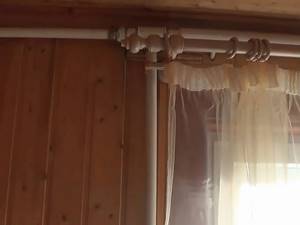
Two-pipe system with bottom wiring
In this case, both supply and return pipes lie at floor level; they can also be laid under it. This system is usually implemented using a sealed expansion tank and a circulation pump. To improve the quality of heat transfer, radiators are connected diagonally here.

From the boiler, which should be positioned as low as possible, water flows through the supply pipes and is supplied to the upper side opening of the radiator, and is discharged from it through the lower one into the return pipe. The advantage of this scheme is that it fits perfectly into the interior. However, the air is released manually through Mayevsky taps installed on each radiator, which is inconvenient.
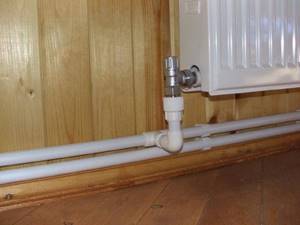
Electric type of cottage heating
Electric heating is perhaps the easiest way to heat a room. The system operates silently, is easy to operate, does not require special maintenance, and is also environmentally friendly. It is possible to equip electric heating even without large initial financial investments. True, it’s difficult to call this option economical. The electric boiler itself for a cottage is not very expensive. But the operating costs are quite high.
This type of heating is not suitable for all homes. For example, if the living area exceeds 100 sq.m., using electricity for heat supply will not be a profitable solution. And if the wiring power is insufficient, then operation will also be unsafe. The method is more suitable for houses in which residents do not live permanently.
Why is it profitable to heat your home yourself?
In terms of heating, owners of country houses are luckier than city residents. After all, cottage owners can turn on the heating in their home at any time of the year, since they do not depend on a centralized heating system. Other advantages and benefits include:
- the ability to turn on the heating in the house at those moments when it is necessary.
- the ability to adjust the temperature to the desired level.
- the ability to independently select heating options (solid fuel, electricity, gas).
However, here the main question arises - how to heat a house economically and what heating method is considered the most profitable? This is what we have to figure out.
Heating a cottage with a solid fuel boiler
When considering heating boilers for a summer residence, it is worth focusing on solid fuel products. This system allows you to save a lot on heating costs. The efficiency of modern models is high. The units are durable, environmentally friendly and safe. More suitable for people with average income. One of the disadvantages is the need for frequent boiler maintenance.
Many people today prefer pellet boilers. This heating installation in a wooden house allows you to automate the work process as much as possible. The operating mode can be programmed. The efficiency of pellet boilers is higher than that of solid fuel boilers. The system is fire and explosion proof. And also does not require special maintenance.
How the system works
If you plan to conduct heat into the premises yourself, it is worth understanding the design and operating principle of water heating. Three components of any scheme:
- installation that generates thermal energy and transfers it to water;
- piping;
- heating devices located in heated rooms.

The principle of operation of the system is based on the transfer of heat from a source to heating devices through a liquid working fluid - ordinary water, capable of absorbing a large amount of energy (specific heat capacity - 4.18 kJ / kg • ° C ). In some cases, a non-freezing liquid is used - an aqueous solution of ethylene glycol or propylene glycol. How does this happen:
- By burning hydrocarbon fuel or consuming electricity, the installation heats water to a temperature of 40...90 degrees.
- The hot coolant moves through the pipes using a pump or naturally (due to convection) to water radiators.
- Heat exchange occurs between the heating devices and the air in the rooms - the water flowing through the radiator cools by 10-20 °C, and the atmosphere of the room warms up. Plus, the hot surface of the radiator emits infrared thermal radiation.
- The cooled coolant is returned through the line to the heat generator, where it is again heated to the required temperature.
- Excess water formed during thermal expansion enters a special container. When the temperature in the system drops, the liquid contracts again and leaves the expansion tank.
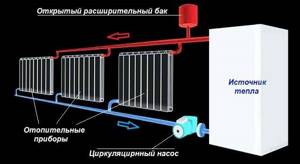
Heating operating cycle - water is heated by the boiler unit, sent through pipes to radiators, where it gives off heat to the surrounding air
Before heating, remember one rule: heating efficiency practically does not depend on the volume of water in the system. This indicator only affects the rate of heating/cooling of the house when starting or stopping the heat generator.
Let's list the really important characteristics:
- temperature difference at the inlet and outlet of the home heater, maximum permissible - 25 degrees;
- source power - must be selected by calculating heat losses through external walls + heating air for ventilation;
- coolant flow - the volume of water passing through heating devices within 1 hour;
- the hydraulic resistance of the pipeline network together with radiators should ideally not exceed 1 Bar (10 m of water column).
An explanation regarding the total volume of coolant in the pipes will be given by expert Vladimir Sukhorukov in his video:
Types of water heating systems for cottages
There is a water heating scheme for a cottage with forced and natural movement of the coolant. Natural circulation is characterized by the energy independence of the heating devices used. The movement of water is carried out due to the difference in water pressure. The system is suitable for one-story houses with an area of no more than 100 sq.m.
But the forced heating system for a country house can be chosen for rooms with an area of more than 100 sq.m., and is more efficient. Can also be used for 3-4 storey buildings. One of the disadvantages is the dependence on a constant source of electricity. After all, for the operation of the system, special circulation pumps are used, which operate from the network. This scheme is financially more expensive than the gravity-fed option.
Features of heating circuits
The optimal coolant for a two-story private building is water.
However, the design of water heating schemes differs:
- type of wiring - top or bottom;
- number of pipes - one-pipe system or two-pipe;
- riser location - vertical or horizontal;
- circulation - forced or natural;
- coolant movement - dead-end or main.
For heating a private house, a scheme with natural circulation is considered optimal. The number of floors of the heated building does not matter in this case. The main thing is to choose the right place where the expansion tank will be located.
For full operation of the system with natural circulation, the tank must be located at the highest point of the building - in the attic or on the second floor.
Thanks to this placement of the tank, the coolant moves from top to bottom, ensuring uniform heating of the radiators, and, accordingly, the air in the rooms.
Photo:
The required direction of movement of the coolant is possible, provided that the pipes are laid at an angle.
In addition, as you approach the boiler, the diameter of the pipes through which the coolant flows back must expand.
The main advantages of a natural circulation system: independence from power supply, simplicity and reliability of operation, absence of noise.
The main disadvantages of a natural circulation system:
- complex installation associated with laying pipes at an angle;
- lack of pressure to heat large areas;
- depending on the direction of movement of the coolant, a temperature difference is observed, which negatively affects the operation of the tank;
- oxygen contained in the coolant contributes to the internal destruction of the system with natural circulation;
- it is necessary to control the coolant level, adding it as it evaporates, which leads to the formation of scale on the inner surface of the pipes.
An alternative to a heating system with natural circulation of coolant is a forced circulation scheme.
Which system to choose for heating a cottage?
The choice of heating system for a country house depends on its purpose.
Some buildings are used mainly in the summer. Therefore, lightweight materials are used for construction. The temperature difference inside and outside the room in this case is small. For such cottages, electric or stove heating is more suitable. If the cottage is intended for permanent residence, the heating and water supply of the country house should be year-round. In this case, it is better to give preference to the water type of heat supply or electric.
The availability of a particular source of thermal energy is of no small importance. If gas is installed in the area, you can equip the system with a gas boiler. The financial side must also be taken into account. You will have to spend money on purchasing the necessary equipment, fittings, pipes, and installation work. It is worth remembering the costs of ongoing operation and periodic maintenance.
Thus, different options can be used to equip the cottage heating system. To choose a heating method, you need to know the characteristics of each, take into account the characteristics of the room, proximity to the heat source and a number of other factors. The efficiency and quality of heating the cottage depends on how correctly and successfully the type of heat supply is chosen.
System Warm floors
This type of room heating is most convenient when it is necessary to heat a given area. At the same time, the air temperature on the floor and near the ceilings is approximately the same.
To install the system, you need to lay pipes over the entire surface of the floor at an equal distance from each other. Then the floors are covered with screed. In addition, heated floors are economically a very expensive thing that heats a small area; the cost of installing heating for a cottage in this case is not as high as subsequent costs. This heating system is possible as an addition to the main one.
The baseboard system is similar to a combination of “warm floor” and water heating. The pipes connecting the boiler and radiators are located along the walls along the baseboard. With this installation of the system, heat flows evenly to both walls and floors. Therefore, the air temperature in the house is the same and there are no significant differences. Let us remind you that a baseboard heating system can be installed in an already finished building, but “warm floors” can only be installed at the stage of construction or repair of floors.
The baseboard heating system is superior to the radiator one. This is due to the fact that the pipes run along the entire perimeter of the room at the bottom of the wall. At the same time, both floors and walls warm up. Also important is the fact that the plinth system takes up less space and can be hidden from prying eyes with furniture.
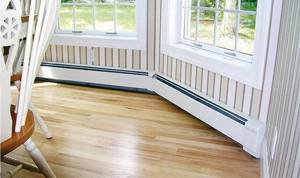
Baseboard heating system
Before installing any heating, it is important to prepare a cottage heating project. Indicate the areas and areas of window openings, doors and loggias
Having these values in hand, you can determine the percentage of heat loss. With heat losses of 8 kW, it is better to buy a boiler with a power of 12 kW. The heating design of a cottage includes: placement of the boiler and chimney, location of radiators by zone.
Connect the boiler and chimney tightly to prevent combustion products from entering the room. If you are using a floor-standing boiler, place a sheet of iron underneath to prevent the floor from catching fire. Before installing the boiler, read the equipment installation instructions and take into account all recommendations. Remember, proper installation of cottage heating systems is the key to a safe and warm atmosphere in a country house in winter.
Choosing a suitable scheme
After familiarizing yourself with the heating systems used in two-story houses, it’s time to return to your draft project, where the types of radiators and boiler are selected, the arrangement of this equipment is determined, and wishes are listed. Next, select a scheme in accordance with the recommendations:
- If there are frequent power outages, the choice is small - you need a gravity system. If the house is heated with a brick stove, you should use it as a heat source and not buy a boiler.
- If you still don’t understand what you want, feel free to assemble a closed-type two-pipe dead-end circuit. It can be easily adapted to different conditions and equipment. Subsequently, install a solid fuel, gas or electric boiler - there is no difference, the heating will work.
- If you have increased requirements for interior design, start with manifold wiring. In order not to make a mistake with the size of the pipes, pull the diameter of 32 mm to the comb, and make connections to the batteries Ø16 x 2 mm (outer).
- Warm floors are installed if there are funds and desire. It is better to combine them with any system other than gravity.
In a small country house with 2 floors, it is worth making a one-pipe system from PPR pipes. With 3-4 batteries on each branch it will work flawlessly. We do not recommend using Leningradka in a large cottage. For more information about choosing a wiring, watch the video from an expert:
